AWM41 997 - [Nurses Narratives] F M Looker
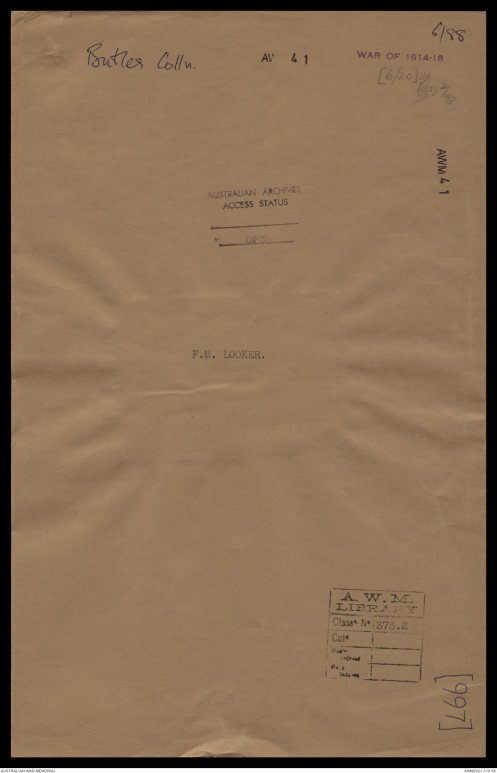
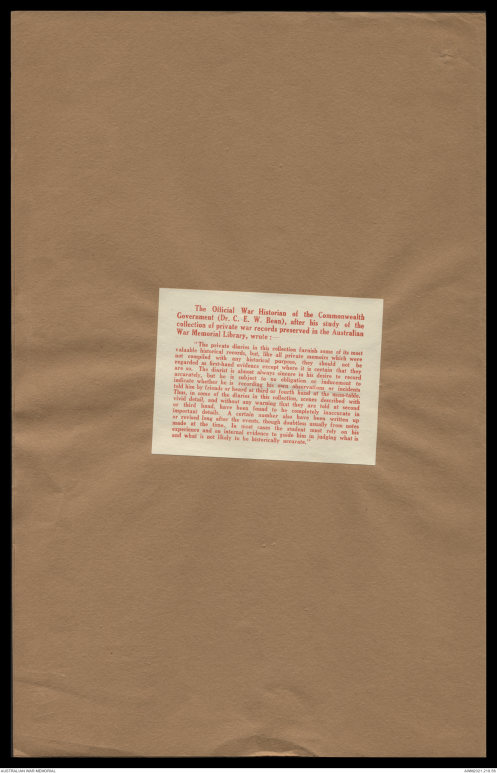
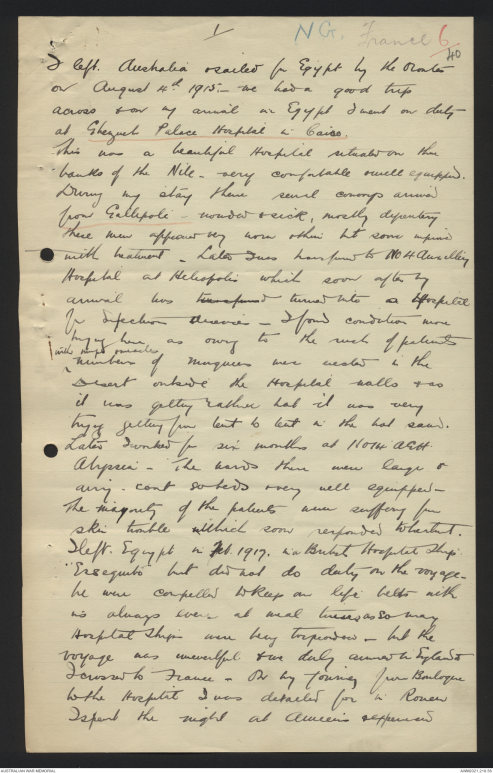
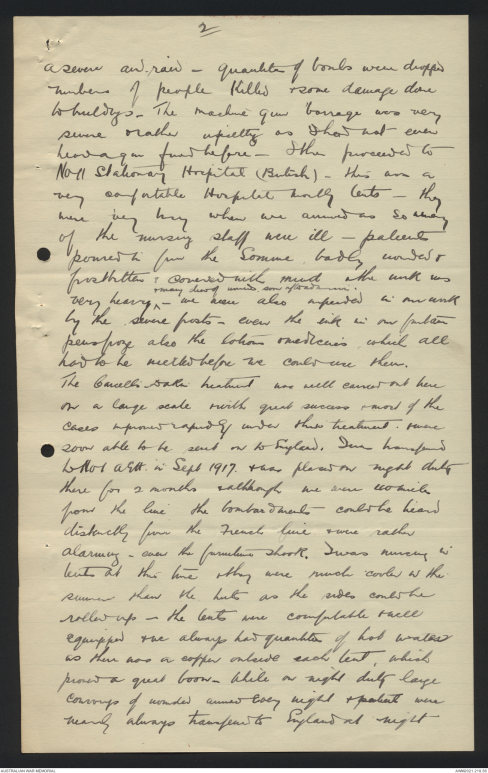

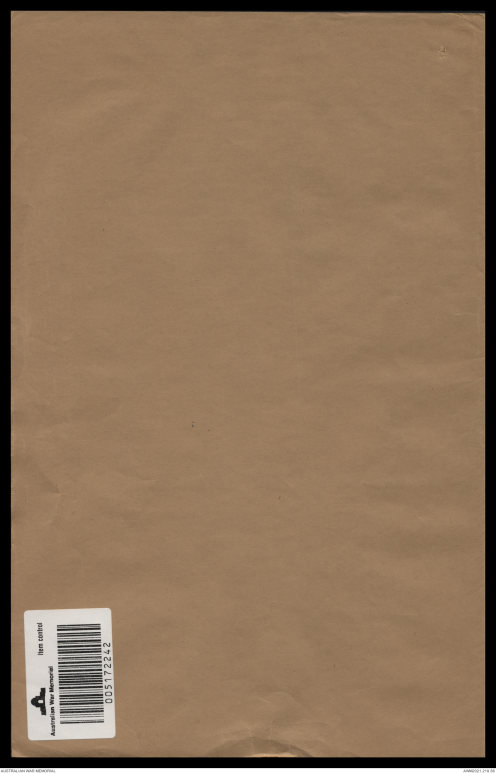
6/88
Butler Colln.
AWM 4 1
WAR OF 1914-18
[6/20]AA
AWM 4 1
AUSTRALIAN ARCHIVES
ACCESS STATUS
OPEN
F.M. LOOKER.
A.W.M.
LIBRARY
Classn No 373.2
[997]
The Official War Historian of the Commonwealth
Government (Dr. C. E. W. Bean), after his study of the
collection of private war records preserved in the Australian
War Memorial Library, wrote:-
"The private diaries in this collection furnish some of its most
valuable historical records, but, like all private memoirs which were
not compiled with any historical purpose, they should not be
regarded as first-hand evidence except where it is certain that they
are so. The diarist is almost always sincere in his desire to record
accurately, but he is subject to no obligation or inducement to
indicate whether he is recording his own observations or incidents
told to him by friends or heard at third or fourth hand at the mess-table.
Thus, in some of the diaries in this collection, scenes described with
vivid detail, and without warning that they are told at second
or third hand, have been found to be completely inaccurate in
important details. A certain number also have been written up
or revised long after the events, though doubtless usually from notes
made at the time. In most cases the student must rely on his
experience and on internal evidence to guide him in judging what is
and what is not likely to be historically accurate."
1
NG. France 6/40
I left Australia & sailed for Egypt by the Orontes
on August 4th 1915._ we had a good trip
across & on my arrival in Egypt I went on duty
at Ghezireh Palace Hospital in Cairo.
This was a beautiful Hospital situated on the
banks of the Nile. very comfortable & well equipped.
During my stay there several convoys arrived
from Gallipoli - wounded & sick, mostly dysentery
these men appeared very worn & thin but some improved
with treatment. Later I was transferred to No 4 Auxiliary
Hospital at Heliopolis which soon after my
arrival was transferred turned into a Hospital
for Infectious diseases - I found conditions more
trying here as owing to the rush of patients
∧with mumps & measles numbers of marquees were erected in the
desert outside the Hospital walls & as
it was getting rather hot it was very
trying getting from tent to tent in the hot sand.
Later I worked for six months at No14 AGH
Alyssia - The wards there were large &
airy- cont 80 beds & very well equipped -
The majority of the patients were suffering from
skin trouble xwhich soon responded to treatment.
I left. Egypt in Feb. 1917. in a British Hospital Ship
"Essequibo" but did not do duty on the voyage.
We were compelled to keep our life belts with
us always even at meal times as so many
Hospital Ships were being torpedoed - but the
voyage was uneventful & we duly arrived in England &
I crossed to France - On my journey from Boulogne
to the Hospital I was detailed for in Rouen
I spent the night at Amiens & experienced
2
a severe air raid - quantities of bombs were dropped
numbers of people killed & some damage done
to buildings. The machine gun barrage was very
severe & rather upsetting as I had not even
heard a gun fired before - I then proceeded to
No 11 Stationary Hospital (British) - this was a
very comfortable Hospital mostly tents - they
were very busy when we arrived as so many
of the nursing staff were ill - patients
poured in from the Somme badly wounded &
frostbitten & covered with mud & the work was
very heavy ^& many died of wounds, some after admissn - we were also impeded in our work
by the severe frosts – even the ink in our fountain
pens froze also the lotions & medicines which all
had to be melted before we could use them.
The Carrell's Dakin treatment was well carried out here
on a large scale & with great success & most of the
cases improved rapidly under this treatment & were
soon able to be sent on to England. I was transferred
to No 1 AGH. in Sept 1917. & was placed on night duty
there for 2 months & although we were 40 miles
from the line the bombardments could be heard
distinctly from the French line & were rather
alarming - even the furniture shook. I was nursing in
tents at the time & they were much cooler in the
summer than the huts as the sides could be
rolled up – the tents were comfortable & well
equipped & we always had quantities of hot water
as there was a copper outside each tent, which
proved a great boon. While on night duty large
convoys of wounded arrived every night & patients were
nearly always transferred to England at night
3
so the patients had rather disturbed nights – the wounds
were mostly amputations & very severe - Carells Dakin
treatment was used on these cases with great success
most of them clearing up so rapidly that they
were fit to travel to England in a few days -
The rest of the year was very busy & in Oct
after the Cambrai stunt the men arrived with huge
∧dirty wounds ma^ny of which were "gassed" when they
arrived & died very suddenly ^soon afterwards- At the
begining of 1918 things were quieter but we became very
busy again in March & for months patients poured
in- every nationality. Jocks. Tommies - Canadians - Americans
Australians, New Zealanders - Newfoundlanders - French Canadians
who couldn't speak a word of English - S. Africans & Indians
I used to love to see the Jocks coming in mostly walkers
with their kilts on - they were always so cheerful - most
of the walkers (men with slight wounds) were so sleepy when
they arrived they couldnt even wait to eat before they fell
asleep. Then ^convoys of gassed ^men (shell) arrived - it was most pathetic
as they could not see for about 3 days their eyes
were so swollen & they also had to be fed.
Their eyes were bathed c̄ Sol. Sodium Bicarb ½ hrly
& some were burnt from head to foot with mustard gas.
These cases were most pathetic to see as they were
quite helpless for a few days, but ^I think most recovered
who got as far as the base. Then we had the
influenza epidemic, a large number of whom
died of pneumonia - lots were just dying when they
arrived after hours in the trains. & we could do
very little for them. Then the Armistice came &
shortly afterward No 1 closed down
I arrived in England on Xmas day -
Effie. M. Looker.
Item control
Australian War Museum
005172242
 Loretta Corbett
Loretta CorbettThis transcription item is now locked to you for editing. To release the lock either Save your changes or Cancel.
This lock will be automatically released after 60 minutes of inactivity.